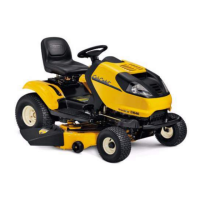ELECTRICAL SYSTEM
132
6c. Squeeze the bulb on the hydrometer, then
insert the hose into the cell.
6d. Release the bulb, drawing electrolyte into
the hydrometer to the fill line.
IMPORTANT: Hold the hydrometer straight up
and down when drawing up the electrolyte. The
float needs to float free, not rubbing against the
sides of the hydrometer.
6e. Write down the specific gravity of each cell.
6f. The readings must be corrected for the tem-
perature of the electrolyte. The hydrometer
manufacture should list the temperature the
float is calibrated to. Most are calibrated to
80
o
. To correct the reading, add .004 to the
reading for every 10
o
Above the calibrated
temperature or subtract .004 for every 10
o
below the calibrated temperature.
6g. Compare the reading to the chart.
IMPORTANT: To prevent damage to the charg-
ing system disconnect the battery to charge it.
NOTE: If battery needs to be charged, let battery
sit for ten minutes to stabilize after charging.
Apply a load to the battery for 15 seconds to
remove the surface charge. Then re-check the
battery.
Battery Testers:
There are four major ways to check a battery:
• Electrolyte test using a Specific Gravity tester
to compare the density of the electrolyte in a
fully charged battery to the density of water
(water = 1.0 s.g.).
• Electrolyte test using a Refractometer to check
the density of the electrolyte by measuring the
degree to which light waves bend when passing
through the electrolyte.
• Load test that checks the output of the battery
after the fully charged battery has done a certain
amount of work. Fixed load testers are com-
monly available. Variable load testers are not
generally found in outdoor power equipment
repair shops.
• Capacitance test that checks the condition of
the battery plate core, regardless of the level of
charge.
Testing the battery
1. Adjustable load testing
Adjustable load testing is used if an adjustable load
tester is available. Follow the procedures specified by
the manufacturer of the tester to connect to the battery.
1a. Disconnect the battery cables.
IMPORTANT: Disconnect the negative cable
first to help prevent a shorting hazard.
1b. Measure the temperature of the electrolyte.
1c. Connect a voltmeter and the load tester to
the appropriate terminals.
1d. Hook an amp probe onto the ground lead of
the load tester.
NOTE: A shunt can be used in place of the amp
probe, but a second voltmeter will be needed to
get a measurement from the shunt.
1e. Apply a load equal to 50% of the battery’s
rated CCA for 15 seconds.
Specific Gravity Charge Condition
1.265
Fully Charged
1.225
75% Charged
1.190
50% Charged
1.155
25% Charged
1.12
Fully Discharged

